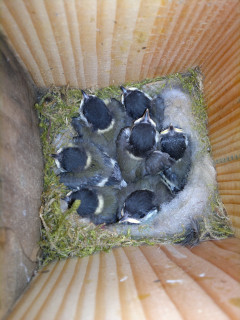Reproduction in birds
All birds are oviparous, meaning that females lay eggs in which the embryo will complete its development before hatching. In order for the chicks to actually see the light of day, the adults undergo a complex reproductive process ranging from courtship to feeding the chicks.
The formation of couples
In temperate zones, the breeding period takes place in spring. The mating is preceded by a set of special events: the courtship.
The male, adorned with a new plumage, often special (wedding plumage), seeks to captivate the female by the display of his finery, dances, fights with other males and, most often, by his song whose qualities are developed at this time. Often, the male also makes small gifts to his beautiful. When the couple is constituted, it can last until the end of the summer, but rarely beyond.
The reproductive system
In the female, the ovary appears as a cluster of reproductive cells that mature successively. The mature egg is collected by a large pinna and descends into the tube, or oviduct, where it can be fertilized.
In the male, the mating organ, or penis, is absent except in exceptional cases. In the majority of cases, during mating, the spermatozoa arrive in the male's cloaca through the vas deferens and are released into the female's cloaca. They then go up into the oviduct to meet the egg. Fertilization is thus internal.
The couple will then look for a hidden or inaccessible place where the female can lay her eggs. Most birds build a nest on a branch fork in a tree or shrub, but some lay their eggs in a hole in a tree (Chickadee), in a building wall or under a roof (House Sparrow, Black Swift). Finally the swallows elaborate cups in mud under a ceiling or a windowsill.
The egg
The large bird egg has a complex structure:
The egg consists of the yolk or vitellus. It carries on its surface the germ or germinal vesicle which will develop into an embryo if fertilised. This yolk contains nutrient reserves rich in lipids (fats).
During its transit through the oviduct, the yolk, covered by the vitelline membrane, is surrounded by the albumen, which is made up of several layers. The albumen is made up of proteins and represents an additional reserve for the embryo. It also helps to absorb shocks.
The first layers of the egg white extend towards the poles in spiral cords: the chalazas, which allow the yolk to maintain the germ on the surface when the egg is subjected to movement. In fact, the germ can only develop if it remains on the surface of the yolk.
Around the albumen are two shell membranes. When the egg is laid, the cooling of the egg causes a contraction of these membranes, which results in the formation of an air pocket at the tip of the egg. The shell membranes also serve to protect the yolk from microbial infection.
The outer shell, acquired at the end of the journey through the oviduct, consists of crystals of mineral salts including calcium carbonate and proteins. Tiny spaces between the crystals, called pores, allow air to enter the egg. The arrangement of the crystals gives the shell great strength by allowing it to withstand pressure from the outside. When the egg hatches, the chick easily breaks the shell with its beak because the beaks come from the inside and the shell has become thin and fragile.
In birds, the egg hatches outside the female's body; birds are oviparous animals. Laying eggs in the open air is of great interest: from the very first stages of its growth, the embryo is surrounded by a protective environment that provides for all its needs, and its mother has a certain amount of latitude to feed or flee from predators.
The laying of eggs
Many birds lay eggs only once a year but some species lay several times a year, as soon as the young are raised (2 clutches in most of the Chickadees and the Redstart, up to 3 clutches in the Blackbird).
The eggs are laid in the morning, and are laid at least one day apart. In order for all the eggs to hatch at the same time, the female does not begin incubation until all the eggs have been laid. Only raptors start incubating from the first egg, the chicks will not be the same age, the youngest will die first if there is not enough food.
Recognising the nests and eggs of the most common birds
Identifying the nests and eggs of garden birds:
http://www.ornithomedia.com/pratique/identification/identifier-nids-oeu…
Brooding
The eggs must remain most of the time at a constant temperature close to the bird's body temperature. The incubating adult turns them regularly to distribute the heat inside. The ventral part of its body, which covers the eggs, loses its feathers to guarantee the transmission of a maximum of heat. This incubation period starts only when all the eggs are laid. Its duration varies in the small birds between 10 and 15 days (13 or 14 days in the titmouse and in the thrushes).
The brooding is practiced either by the female alone, or alternately by the male and the female and sometimes by the male alone. While the female broods, the male brings her food and often the charm of his song.
Feeding of the young
There are two kinds of behavior of the young after hatching:
-
Nesting species whose young are born with down and can leave the nest and feed on their own as soon as they hatch, such as the Meadow Quail.
-
Nesting species whose chicks are born naked and blind and are dependent on their parents for some time. The parents then do not cease to feed them. For example, in the great tit, the feeding time is 17 hours per day during which the parents bring 30 to 50 insects per hour to their young. These pass from a weight of birth of approximately 1,3 grams to that of 18 grams in less than 15 days.
Bibliography
La Hulotte
We advise you to read the always fascinating issues of La Hulotte: 11, 16, 19 and 35. 35.




